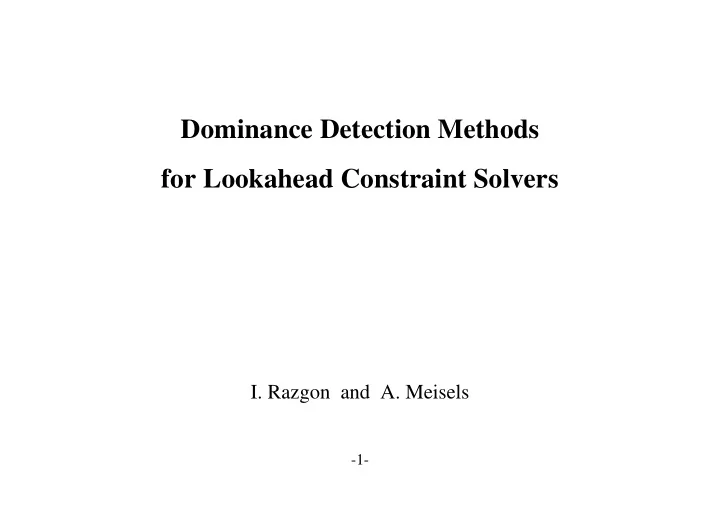

Dominance Detection Methods for Lookahead Constraint Solvers I. Razgon and A. Meisels -1-
Contents 1. Problem Presentation 2. Algorithms 3. Preliminary results and further investigation 4. Related work 5. Conclusion -2-
Future values of a partial solution The main feature of forward checking (FC): visiting a partial solution P, it deletes from all domains of unassigned variables values that are inconsistent with P We call the rest of the domain values of unassigned variables F the future values of P and refer to it as P Future values of a partial solution, for other types of domain filtering methods can be defined analogously -3-
A Dominance Relation Let P be the current partial solution and let V be the current ( ) ( ) variable of FC. A value dominates a value if val 1 V val 2 V ⊆ F F { , } ∪ < > p V val 2 { , } ∪ < > P V val 1 ( ) ( ) Claim: If dominates given val 1 V val 2 V P { , } ∪ < 1 > P V val and is a nogood { , } ∪ < 2 > then is also a nogood P V val { , } ∪ < 2 > Therefore: can be rejected without search P V val -4-
A Problem: Dominance Detection Let P, V be the current partial solution, and the current variable. { ( ),..., ( )} Let be the set of values of V, val V val V 1 m that have been assigned in the past. Determine whether is dominated by one of ( ) val m + 1 V { ( ),..., ( )} given P. val V val V 1 m If positive, reject without checking. ( ) val m + 1 V -5-
A Problem: An Optimal Ordering Let P, V be the current partial solution and the current variable of FC. Determine the ordering of values such that the number of dominance detection instances is maximal. Comment: actual dominance’s are only detected when values are replaced during search. -6-
Dominance Detection 2 ( ) The problem can be solved in , where n is the number O nm of variables, m is the maximal domain size. To solve this problem, one can check if the future set corresponding to the current assignment of the assigned variable is included in a future set corresponding to some its past assignment. To avoid recomputation of future sets after backtrack, a memoization of already computed future sets for all prefixes of the current partial solution is needed -7-
An Optimal Ordering Ordering the values of the current variables by decreasing order of sizes of the corresponding sets of future values yields the maximal number of dominance' s discovered (when the current partial solution is a nogood) This heuristic has been shown to be very useful for search [Frost, Dechter 1995] -8-
Preliminary Experimental Results FC enriched with the described value ordering heuristic and dominance detection procedure was tested on random problems. The method is most effective for instances with low density This may be particularly useful for tight constraint networks with a large number of variables -9-
A further development: a good variable ordering heuristic A variable ordering heuristics based on constrainedness notion [Smith 1996] seem to be a good choice for support for the method presented. -10-
Related work: The presented method is an extension of Symmetry Breaking via Dominance Detection for domains of variables [Fahle 2001] -11-
Conclusion • A dominance relation for lookahead constraint solvers was defined • A dominance detection method was presented • An optimal ordering strategy for the dominance detection method was described • Preliminary experimental results are positive -12-
Recommend
More recommend